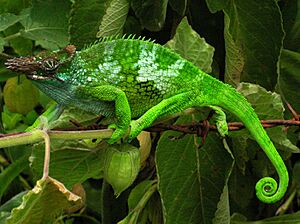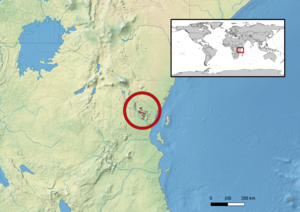West Usambara two-horned chameleon facts for kids
Quick facts for kids West Usambara two-horned chameleon |
|
|---|---|
 |
|
 |
|
| Male above, female below | |
| Conservation status | |
| Scientific classification | |
 |
|
| Synonyms | |
|
Chamaeleon fischeri multituberculatus Nieden, 1913 |
The West Usambara two-horned chameleon (also known as the West Usambara blade-horned chameleon) is a special type of chameleon. Its scientific name is Kinyongia multituberculata. This chameleon lives only in the western part of the Usambara Mountains in Tanzania, a country in East Africa.
For many years, people often mixed up this chameleon with another one called Fischer's chameleon (K. fischeri). But scientists now know they are different species. Fischer's chameleon does not live in the Usambara Mountains at all. The West Usambara two-horned chameleon does not have any very close relatives living in the same area. However, two other similar chameleons, K. matschiei and K. vosseleri, live only in the eastern Usambara Mountains.
Contents
Where Do They Live? (Habitat)
These chameleons live in cool, moist forests in the West Usambara Mountains. These forests are found high up, between 1,200 and 2,500 meters (about 3,900 to 8,200 feet) above sea level.
They can also be found in areas near these forests, like on bushes and trees next to roads. However, they need places with lots of plants and hiding spots. They cannot live in open areas where the land has been changed a lot by people.
Protecting These Chameleons (Conservation)
The forests where these chameleons live are facing problems. People sometimes cut down trees for wood or use the land for farming. This means the chameleon's home is getting smaller and broken up into smaller pieces. We need to do a better job of protecting these forest areas.
Like many other chameleons, the West Usambara two-horned chameleon is listed under an agreement called CITES. This means that if anyone wants to trade these chameleons internationally, they need a special permit.
In the past, many of these chameleons were caught and sent to other countries to be sold as pets. This happened especially when they were still thought to be Fischer's chameleons. Experts believe that over 95% of the "Fischer's chameleons" sent from Tanzania were actually K. multituberculata. After scientists realized it was a separate species, Tanzania allowed some limited trade for a while. But after 2017, they stopped allowing these chameleons to be exported. This helps protect them in their natural home.
What Do They Look Like? (Appearance)
The West Usambara two-horned chameleon is one of the larger types of chameleons in its group, called Kinyongia. They can grow up to 34 centimeters (about 13 inches) long, with their tail making up more than half of their total length.
Female chameleons do not grow as big as the males. Adult male chameleons have two large horns on their nose that point towards each other. These horns are much smaller in females.
Compared to other similar chameleons, both male and female West Usambara two-horned chameleons have spines along the ridge of their back. These spines go further down their back, sometimes even past the middle. In other chameleons, these spines might only be near the head or not present at all.
See also
- Trioceros deremensis, the Usambara three-horned chameleon


